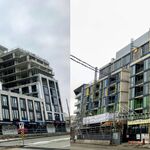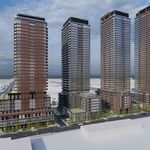turbanplanner
Senior Member
I drove across some of the line yesterday, it seems that the final paving is actually starting/finishing.
It's not like we're calling them "Line 5" and "Line 6" or anything...Who is branding them as subway lines? I have only ever heard them referred to as LRTs.
It's not like we're calling them "Line 5" and "Line 6" or anything...
On the subway map, and branding, it's being advertised as "Line 6." Thinking of mode differences is probably going too deep into the transit advocacy side - people will see this as an extension of the Rapid Transit network ... unless we screw this up.The name doesn't include the word subway. I have only ever heard them referred to as rapid transit/LRT lines. Nevertheless, it's important to set our expectations based on what the project actually is rather than whatever marketing wank Metrolinx trots out.
That being said, a vehicle operating in its own right way of is inherently faster than the status quo, which is a bus without private lanes. And if expecting a local transit vehicle to outpace a car is the parameter by which the success of a transit project is judged, there are many transit lines that could be considered failures.
"It goes faster than buses stuck in traffic."On the subway map, and branding, it's being advertised as "Line 6." Thinking of mode differences is probably going too deep into the transit advocacy side - people will see this as an extension of the Rapid Transit network ... unless we screw this up.
I don't see why we should accept that transit vehicles shouldn't go as fast as possible on their ROWs. Are the subway slow zones acceptable? Should we accept that it's "faster than a streetcar [the Yonge streetcar it replaced in 1954]," and therefore a great success? If the parameter by the success of a billion-dollar transit investment is judged is "faster than a bus without private lanes" (ie. mixed flow), something's gone horribly wrong with planning and operations.
If we want to saddle our suburban LRTs with stupid operational practices as we have on the 510/512, we may as well have called this the "536 Finch West" streetcar, and set those expectations low.
TTC has always branded them as subways, as far as I know. As they did with Line 3 (Scarborough RT).Who is branding them as subway lines? I have only ever heard them referred to as LRTs.
Metrolinx is using the same wayfinding symbol for both Subways and LRTs. I would consider that disingenuousWho is branding them as subway lines? I have only ever heard them referred to as LRTs.
The issue isn't so much the rolling stock as it is the speed of the line. 60km/h is too slow. If we're trying to entice people to get out of their cars, then transit has to go faster. Especially with the amount of money we spent on this project.Just to add to the perceived confusion Crosstown is listed as a Rapid Transit LRT project but the Crosstown West Extension is listed as a Subway project on Metrolink's website. It is of course, completely grade separated as an individual project in and of itself.
Does it matter what power train set is used for such a project to call it a subway if this is the case (forgetting the fact that CWE will become one with Crosstown)?
Line 6 is a tram/LRT IMO. Line 5 is a strange one, Reminds me a little bit of the Metrolink I used to take in Manchester (which was really good).
Even before all this crap they were doing 50-60 km/h beside the Allen. They couldn’t even build the stretch for 80 km/h.TTC: Major Operational Issues (Various)
Given the state of disrepair that the TTC has been in over the past few years, and the increased amount of construction taking place throughout the system I figured it's time to create a separate thread to keep track of all of it and separate it from the catch all thread. I'll start things off...urbantoronto.ca
C-train stations are usually 2km apart in the suburbs similar to North Yonge. It’s a lot easier to hit 80 but access is quite difficult. Most people drive to the stations and park there.The issue isn't so much the rolling stock as it is the speed of the line. 60km/h is too slow. If we're trying to entice people to get out of their cars, then transit has to go faster. Especially with the amount of money we spent on this project.
Calgary C-train hits an average speed of 80km/h
One major reason why this may be is because, on a local transit line (which this is), there is only so much speed you can attain, before you have to slow down again for the next stop. And the higher the top speed is, the longer the braking distance will be, and, paradoxically, the less time the vehicle will spend operating at top speed before it has to start braking.don't see why we should accept that transit vehicles shouldn't go as fast as possible on their ROWs.
I don't think this is a 1 on 1 comparison, because the subway slow zones are artificial speed restrictions caused by infrastructure decay. A much fairer point of comparison would be the design speed of line 1. From Bloor to Eglinton West, even in times of good maintenance, it is still relatively slow for a subway, due to the timers and curves on the line. Or, here's the original comment which set off the discussion:Are the subway slow zones acceptable? Should we accept that it's "faster than a streetcar [the Yonge streetcar it replaced in 1954]," and therefore a great success? If the parameter by the success of a billion-dollar transit investment is judged is "faster than a bus without private lanes" (ie. mixed flow), something's gone horribly wrong with planning and operations.
These trains need to be seen outpacing cars.
What operational practices are you referring to? I haven't seen anyone refer to this. All we're talking about is how the line will have the same speed limit as the street it's on, which, if Google streetview imagery is still accurate, is 60 km/h. How is this a problem?If we want to saddle our suburban LRTs with stupid operational practices as we have on the 510/512, we may as well have called this the "536 Finch West" streetcar, and set those expectations low.
I don't want this to sound offensive, but to me it sounds like your expectations for transit are entirely too high.The issue isn't so much the rolling stock as it is the speed of the line. 60km/h is too slow. If we're trying to entice people to get out of their cars, then transit has to go faster. Especially with the amount of money we spent on this project.
Calgary C-train hits an average speed of 80km/h
I agree transit speed definitely can affect whether people use it, at least for myself. I live right downtown by several streetcar lines right by me, however they are so painfully slow that for shorter distances I choose to cycle and for longer (more than 8 km ish) I usually drive as it's faster. Out of cycling, driving and taking the TTC, the TTC is almost never faster sadly, and usually the slowest.The issue isn't so much the rolling stock as it is the speed of the line. 60km/h is too slow. If we're trying to entice people to get out of their cars, then transit has to go faster. Especially with the amount of money we spent on this project.
Calgary C-train hits an average speed of 80km/h

Looks like it's 80 km/hr to 0 km/hr very quickly today!Calgary C-train hits an average speed of 80km/h




